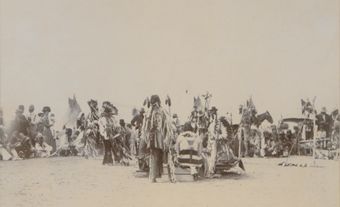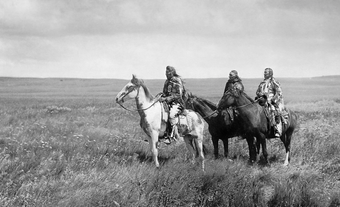
Siksikaitsitapi: The Blackfoot People
The South Piikani occupied territory now considered part of present-day Montana in the United States. They call themselves the Blackfeet of Montana, though the name is written by some as Pikuni. Their reservation covers a large area east of the Rocky Mountains. ( See also Indigenous Territory.)
The other three First Nations are now located on reserves in Alberta: Siksiká near Gleichen, east of Calgary; Aapátohsipikani at Brocket, west of Fort Macleod; and Kainai north of Cardston. All reside on Treaty 7 territory (See also Numbered Treaties).
Algonquian Linguistic Family
Blackfoot is a member of the Algonquian family of languages. This means that there is clear evidence that Blackfoot and other members of the Algonquian family are all descendants of a single language spoken perhaps thousands of years ago. Though there is no record of that parent language (known as proto-Algonquian), its existence is thought to explain the regular correspondences of sounds and grammar when Algonquian languages are compared to one another. Some other languages in the family are Cheyenne, Mi’kmaq, Cree, Arapaho, Delaware, Ojibwe, Kickapoo, Algonquin and Shawnee.
One hypothesis about the distribution of these languages is that, as speakers of the parent language moved eastward across Canada, the portion that remained behind near the Rocky Mountains are the ancestors of the Blackfoot people. The rest of the Algonquian people moved to an area near the Great Lakes, then broke up into smaller groups which fanned out from there, the Cree all the way back to the Rocky Mountains. This would account for the fact that Blackfoot looks different from many Algonquian languages.A comparison of Blackfoot nouns with nouns of some other Algonquian languages, for example, turns up few pairs of words that look similar; so few in fact, that one would suspect that they are just coincidental similarities.
However, other language experts refute this west-to-east theory, arguing that Algonquian languages moved in the other direction. The extent to which Blackfoot vocabulary is different when compared to that of other Algonquian speakers could be explained if there was mixing with another language at some point in the history of Blackfoot, similar to that in the history of Michif, which has French nouns and Cree verbs. However, no one has yet been able to recognize any existing language as a source for Blackfoot nouns that are apparently not Algonquian in origin.
Comparison of Blackfoot and Cree
There are plenty of lexical items in Blackfoot that can be shown to be of Algonquian origin. Moreover, as soon as one becomes familiar with the grammar of Blackfoot and some other Algonquian language, the relationship is obvious. This comparison of Blackfoot and Cree demonstrates similarities in the languages’ respective possessed forms for “mother”:
|
Cree |
|
|
my mother |
nikâwiyinân |
our (not including you) mother |
|
|
kikâwiyinaw |
our (including you) mother |
|||
|
kikâwiy |
your (singular) mother |
kikâwiyiwâw |
your (plural) mother |
|
|
okâwiya |
his/her mother |
okâwiyiwâwa |
their mother |
|
Blackfoot |
|
niksíssta |
my mother |
|
niksísstsinnaana |
our (not including you) mother |
|
kiksísstsinoona |
our (including you) mother |
|||
|
kiksíssta |
your (singular) mother |
kiksísstowaawa |
your (plural) mother |
|
|
oksísstsi |
his/her mother |
oksísstowaawayi |
their mother |
Notice the identical pattern of prefixes in these two paradigms. The suffixes are also largely the same. Even though the stems for “mother” are different, the pattern of inflection for person of possessor is too similar to be coincidence.
The same degree of similarity is found in the verb affix paradigms. Most impressive is the direct and inverse system seen in transitive verbs which take animate gender objects. Examine the following Cree and Blackfoot pairs of verb forms:
|
Cree |
Blackfoot |
|
nimiweyimânân aniki “we like those” |
nitáákomimmannaani omiksi “we love those” |
|
nimiweyimikonân aniki “those like us” |
nitáákomimmokinnaani omiksi “those love use” |
The verb forms are identical in each pair except for a small portion (highlighted) at the end of the verb stems. These highlighted portions are the direct and inverse markers. Notice also that the prefixes and suffixes of Cree and Blackfoot are again, much alike.
DID YOU KNOW?
“Old Blackfoot” is a variant of the language often spoken by older people and is slightly different than that spoken by younger people — “New Blackfoot.” Old Blackfoot more closely resembles the language spoken by Blackfoot people from the late 1800s to the early 1900s. New Blackfoot may differ in terms of word choice, grammar and word forms. However, the languages are not so different that speakers of either cannot understand one another.
Writing System
An alphabet for Blackfoot was designed by language specialist, Donald G. Frantz, with input from several native speakers of Blackfoot in the 1960s. The alphabet was based on analysis of the Blackfoot sound system, in conjunction with testing speakers’ ease of use. The education committees of the three Blackfoot-speaking reserves in southern Alberta approved this as the official writing system in 1975.
Thirteen letters from the English alphabet were adopted, three vowels and 10 consonants. Most letters in Blackfoot have two distinctive lengths; longer sounds are written double. One of the consonants is not actually represented by a letter, but by an apostrophe: it is a glottal stop, similar to the interruption between the two “oh”s of the expression “oh-oh” in English.
Speaking the Language
As separate bands, both before and during the reserve period, all four Blackfoot nations have developed slightly different dialects of the language. These differences, though few and almost never causing any difficulty in communication, are sufficiently well known that speakers from one reserve can usually identify the dialect of a speaker from another. (See also Indigenous Languages in Canada.)
Notable Features
A Polysynthetic Language
From the point of view of non-speakers, perhaps the most notable feature of Blackfoot is that several meanings and categories that are expressed as separate words in English or French are components of the verb, including negation, adverbials, auxilliary verbs and prepositions. Linguists refer to languages such as this as polysynthetic, meaning that the words of the language consist of many morphemes (i.e., words that carry meaning).
Here is a lengthy verb with analysis of its parts:
Nimátomaakohkottsikkamitapokska’sspa.
“I will not yet be able to run fast to there”
n-imat-oma-ak-ohkott-ikkam-itap-okska’si-hpa.
1-neg-yet-fut-able-fast-to-run-nonaffirm
Gender Categories
Blackfoot, like other Algonquian languages, classifies every noun into one of the two grammatical gender categories, labeled animate and inanimate. The categories are only partially based on semantics. For example, all nouns referring to animals or spirits belong to the animate class, but not all members of this class are living creatures. A person learning the language must learn about which classes of nouns refer to non-living entities.
Did You Know?
The Urban Society for Aboriginal Youth (USAY) has partnered with an augmented and virtual reality company called Mammoth to create Thunder VR, an immersive Blackfoot language preservation and culture learning tool. The virtual reality game, based on a Blackfoot graphic novel called Thunder, tells the ancient Blackfoot story of a man who loses his wife and must travel a great distance to challenge the spirit of Thunder (Ksistsikoom) to get her back. Thunder was developed by USAY youth and Kainai elder Randy Bottle (Saakokoto). The high-tech game, narrated by Saakokoto, is designed to teach the endangered Blackfoot language to a new generation of learners and is being advertised as a “mash-up” of tradition and technology. USAY and Mammoth, two Calgary-based organizations, have received funding from the Government of Canada and are planning to take Thunder VR, along with 27 Oculus Go headsets, to Calgary schools in fall 2019. Thunder VR is available as a free download on Oculus Go.
Current State of the Language
The Blackfoot language is endangered. Since the late 1960s, there has been a gradual decrease in the number of learning speakers. While the 2016 census reported that 5,565 people claimed the ability to speak a Blackfoot language, members of the community contend that this figure might be misleading. The census figure does not distinguish between fluent, conversational and learning speakers. Therefore, the number of people who can fully speak the language is likely lower, with community sources estimating only about no more than 1,500 native speakers, most of whom are likely over the age of 50.
There are several efforts being made to promote use of the language. A number of schools in southern Alberta have classes at the elementary and middle school levels that meet once or twice per week. Mizuki Miyashita, a linguist at the University of Montana, is conducting several projects aimed at increasing use of the language on the Blackfeet reservation. Libraries, museums and friendship centres in community also offer language classes.

 Share on Facebook
Share on Facebook Share on X
Share on X Share by Email
Share by Email Share on Google Classroom
Share on Google Classroom











